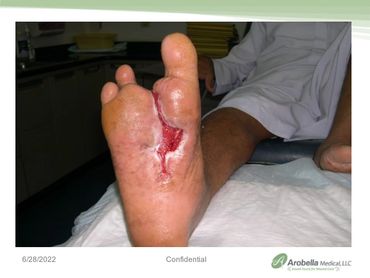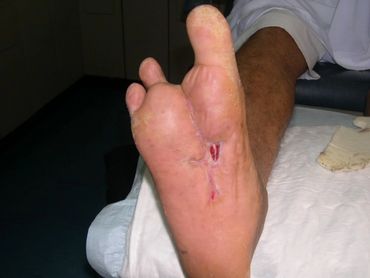
QOUSTIC WOUND THERAPY SYSTEM
Wound Debridement
The flagship device for this technology is the Qoustic Wound Therapy System, a next-generation wound care management product that uses ultrasound technology to treat chronic wounds.
In clinical and scientific literature, the use of ultrasound energy has demonstrated multiple benefits, including destroying bacteria, disinfecting the wound, stimulating cell growth, increasing blood flow, and the near-painless fragmentation of a wound, which aids in the healing process.
Sterile saline solution directs focused ultrasound energy to the wound, where tiny vibrating gas bubbles (cavitation) separate dead and diseased cells from healthy tissue. At the same time, the system delivers ultrasonic vibrations that fragment, destroy, and easily remove non-viable tissue.
The system provides a superior debriding process and allows for more control over the procedure. The unique domed shape of the Qoustic Qurette significantly advances state-of-the-art technology by permitting controlled volumetric removal of unwanted tissue while focusing ultrasonic energy directly on the area of the wound being treated.
While multiple treatments may be required to treat wounds to their target outcomes, treatment with the Qoustic Wound Therapy System™ device has typically required less time and proven significantly more effective and efficient than current standard-of-care, as evidenced by clinical successes with recalcitrant and senescent wounds, which have proven resistant and difficult to heal by standard-of-care means.
The system specializes in the treatment of acute and chronic wounds, such as:
• Infected, Eczematous, Ulcerated, or Devitalized Skin
• Compromised Surgical Wounds
• Venous Ulcers
• Diabetic Foot Ulcers
• Arterial Wounds
• Pressure Ulcers
• Osteomyelitis
• Fistulas
• Burns
Although initially designed for wound care treatment, this technology can easily be integrated into other medical devices. For example, it is currently used in areas outside of wound care (example: the Qourette has been used in many cancer resection and excision procedures (tumor removals)
Advantages
- Selective, precise, and gentle fragmentation of soft and hard tissues
- Preservation of healthy tissue through ultrasonic separation of damaged tissue
- Less pressure and pain
- Reduction of splash created by residuals of sharp debridement and saline wash Improvement in granulation of treated tissue
- Stable delivery of ultrasound energy during procedure
Approximately 9 million Americans suffer from chronic open wounds each year
Video - Introduction to the System
Focused Ultrasound Energy

Bacteria Destruction

Other uses - cancer resection and excision (tumor removal)
Limb Preservation - Prevents Amputations and Gives New Hope
.png/:/cr=t:0%25,l:0%25,w:100%25,h:100%25/rs=w:370,cg:true)
-0001.png/:/cr=t:0%25,l:0%25,w:100%25,h:100%25/rs=w:370,cg:true)
.png/:/cr=t:0%25,l:0%25,w:100%25,h:100%25/rs=w:370,cg:true)



185,000 amputations occur in the United States each year
Foot infected with 5 different types of bacteria
The above photos are of a high ranking official in the Gulf Region whose foot was infected with 5 different types of bacteria. As a result of the infections, two toes had to be amputated. After using the quostic device, the remainder of the foot was saved. Each year, there are over 185,000 amputations in the United States alone. There are over 1 million amputations per year globally.
Wound Debridement Examples
Killed MRSA Bacteria in 180 Seconds (Mayo)
Destroys Bacteria
Video
Photo Gallery

Healing wounds that could not heal.

After debridement. Healthy circulation returns.

Seeing is believing
Photo Gallery


Wound Debridement Without Anesthesia

Technology is so powerful, wound debridement is possible without anesthesia.
System Specifications

The global wound care market size USD 20 billion
Wound Care Market Overview
Target Market, Growth and Trends
The global wound care market size was valued at USD 20.59 billion in 2021 and is projected to grow at a compound annual growth rate (CAGR) of 4.12% from 2022 to 2030. The demand for wound care products is increasing owing to increasing number of surgical cases, and rising prevalence of chronic diseases across the globe. Furthermore, increasing incidence of diabetes due to sedentary lifestyle is one of the leading factors contributing to market growth. For instance, according to American Diabetes Association, in 2018, an estimated 34.2 million people, i.e., 10.5% of the total U.S. population, had diabetes. Moreover, nearly 1.6 million U.S. residents had type 1 diabetes, which includes about 187,000 adolescents and children. Learn More
Increased Burden on Health Care System
There is an ever increasing economic burden for the treatment of chronic and acute wounds being exerted on the health systems in various countries across the globe. Hence, the need for cost effective and innovative products in increasing day by day among the patient population. There is a profound need to introduce new and advanced products with an aim to offer effective and affordable treatment.
Low Frequency Ultrasound
This website uses cookies.
We use cookies to analyze website traffic and optimize your website experience. By accepting our use of cookies, your data will be aggregated with all other user data.